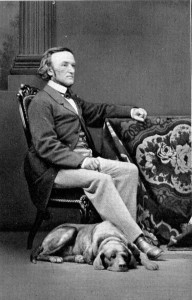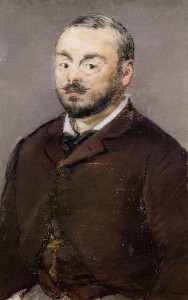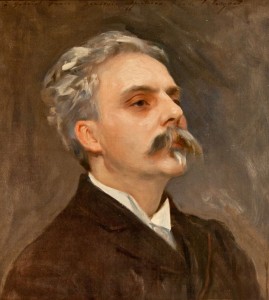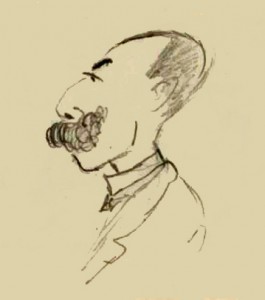
Richard Wagner
Chabrier’ Souvenirs de Munich takes the themes of this serious opera of illicit love and betrayal and makes it into a Quadrille. The quadrille was a simple dance for 4 couples in a square in a set of 5 dances:
1. Le Pantalon (“Trousers”)
2. L’été (“Summer”)
3. La Poule (The Hen”)
4. La Pastourelle (“The Shepherd Girl”)
5. Finale

Édouard Manet: Emmanuel Chabrier (1880) (Ordrupgaard Museum, Charlottenlund, Denmark)

John Singer Sargent: Gabriel Fauré (1896)
Chabrier wasn’t the only composer to take on Wagner’s pompousness. Gabriel Fauré and André Messager travelled around Europe to see Wagner’s operas. Starting in 1878, they saw Das Rheingold and Die Walküre at Cologne Opera; the complete Ring cycle in both Munich and London; and Die Meistersinger in Munich and then went to Bayreuth, where they saw Die Meistersinger and Parsifal. Their Souvenirs de Bayreuth is subtitled Fantasie en forme de quadrille sur les thèmes favoris de l’Anneau de Nibelung (“Fantasy in the form of a quadrille on favourite themes from Der Ring des Nibelungen“). Fauré and Messager’s four-hand party piece is also in 5 movements, but without names.

Caricature of André Messager by Gabriel Fauré
Fauré and Messager: Souvenirs de Bayreuth: I. – (Eric le Sage and Alexandre Tharaud, piano 4-hands)
II. From Das Rheingold, we have the leitmotif of the Tarnhelm.
II. –
III. From Die Walküre, it’s the love song of Siegmund – but done as such as silly skippy melody that when the Valkyries call comes in the middle it’s quite shocking.
III. –
IV. From Die Walküre, it’s a mixture of the magic fire music and Wotan’s music.
IV. –
V. From Götterdämmerung starts with the call of Siegfried and ends with the Rhine maiden’s song as they get their gold back.
V. —
Somehow, the mighty Wagnerian drama of life, love, and death becomes trivialized by the dance rhythms.
These composers all admired Wagner greatly and fully understood how, with his operas, he had changed European music into something greater. At the same time, they could see his tremendous ego operating and could dissect it through their music. The French composer Francis Poulenc, in his biography of Chabrier, described Souvenirs de Munich as “irresistibly funny”, putting Wagner’s principal themes into “false beards and fake moustaches.”



Just heard C’s “caprice”, which seems to refer W’s “Tristan ..” to the Liebestod theme . Right ? Wrong ?